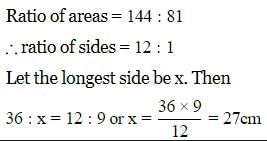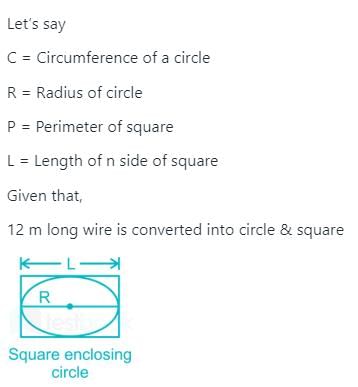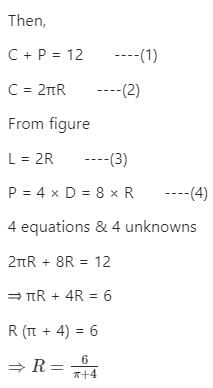All Exams >
Mechanical Engineering >
General Aptitude for GATE >
All Questions
All questions of Mensuration and geometry for Mechanical Engineering Exam
Find the perimeter of the a square with side 4cm.- a)16 cm
- b)12 cm
- c)10 cm
- d)8 cm
Correct answer is option 'A'. Can you explain this answer?
Find the perimeter of the a square with side 4cm.
a)
16 cm
b)
12 cm
c)
10 cm
d)
8 cm

|
Sreesha Phalod answered |
Sol. perimeter of square=4* sides
=4*4 (sides is 4)
=16.
=4*4 (sides is 4)
=16.
Find the volume of a cuboid whose length is 8 cm, width is 3 cm and height is 5 cm. - a)135 cm3
- b)125 cm3
- c)120 cm3
- d)130 cm3
Correct answer is option 'C'. Can you explain this answer?
Find the volume of a cuboid whose length is 8 cm, width is 3 cm and height is 5 cm.
a)
135 cm3
b)
125 cm3
c)
120 cm3
d)
130 cm3
|
|
Tanishq Joshi answered |
Finding Volume of a Cuboid
Given: length = 8 cm, width = 3 cm, height = 5 cm
To find: Volume of the cuboid
Formula: Volume of a cuboid = length x width x height
Substituting the given values in the formula, we get:
Volume = 8 cm x 3 cm x 5 cm
Volume = 120 cm3
Therefore, the correct answer is option C, 120 cm3.
Given: length = 8 cm, width = 3 cm, height = 5 cm
To find: Volume of the cuboid
Formula: Volume of a cuboid = length x width x height
Substituting the given values in the formula, we get:
Volume = 8 cm x 3 cm x 5 cm
Volume = 120 cm3
Therefore, the correct answer is option C, 120 cm3.
Practice Quiz or MCQ (Multiple Choice Questions) with solutions are available for Practice, which would help you prepare for chapter Mensuration, Class 8, Mathematics . You can practice these practice quizzes as per your speed and improvise the topic. Q.Find the volume of a cuboid whose length is 8 cm, breadth 6 cm and height 3.5 cm. - a)215 cm3
- b)172 cm3
- c)150 cm3
- d)168 cm3
Correct answer is option 'D'. Can you explain this answer?
Practice Quiz or MCQ (Multiple Choice Questions) with solutions are available for Practice, which would help you prepare for chapter Mensuration, Class 8, Mathematics . You can practice these practice quizzes as per your speed and improvise the topic.
Q.
Find the volume of a cuboid whose length is 8 cm, breadth 6 cm and height 3.5 cm.
a)
215 cm3
b)
172 cm3
c)
150 cm3
d)
168 cm3
|
|
Ankita Shah answered |
Given,
Length (l) = 8 cm
Breadth (b) = 6 cm
Height (h) = 3.5 cm
We know that the volume of a cuboid is given by the formula:
Volume = length × breadth × height
Substituting the given values, we get:
Volume = 8 cm × 6 cm × 3.5 cm
Volume = 168 cm³
Therefore, the volume of the given cuboid is 168 cm³.
Hence, the correct option is (d) 168 cm³.
Length (l) = 8 cm
Breadth (b) = 6 cm
Height (h) = 3.5 cm
We know that the volume of a cuboid is given by the formula:
Volume = length × breadth × height
Substituting the given values, we get:
Volume = 8 cm × 6 cm × 3.5 cm
Volume = 168 cm³
Therefore, the volume of the given cuboid is 168 cm³.
Hence, the correct option is (d) 168 cm³.
Find the area of a triangle whose base is 4 cm and altitude is 6 cm.- a)10 cm2
- b)14 cm2
- c)16 cm2
- d)12 cm2
Correct answer is option 'D'. Can you explain this answer?
Find the area of a triangle whose base is 4 cm and altitude is 6 cm.
a)
10 cm2
b)
14 cm2
c)
16 cm2
d)
12 cm2
|
|
Kavya Saxena answered |
We know that area of triangle is equals to 1/2 base × altitude.
Here, base = 4 cm and altitude = 6 cm.
So, area = 1/2 × 4 × 6= 24 /2= 12 cm2.
Here, base = 4 cm and altitude = 6 cm.
So, area = 1/2 × 4 × 6= 24 /2= 12 cm2.
A rectangular enclosure 40 m x 36 m has a horse tethered to a corner with a rope of 14 m in length. What is the ratio of the respective areas it can graze, if it is outside the enclosure and if it is inside the enclosure?- a)2
- b)2:3
- c)1:4
- d)3:1
Correct answer is option 'D'. Can you explain this answer?
A rectangular enclosure 40 m x 36 m has a horse tethered to a corner with a rope of 14 m in length. What is the ratio of the respective areas it can graze, if it is outside the enclosure and if it is inside the enclosure?
a)
2
b)
2:3
c)
1:4
d)
3:1

|
Talent Skill Learning answered |
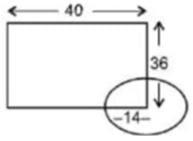
- Imagine a circle on the corner of the rectangle.
- 3 quarters of the circle lie outside the rectangle and 1 quarter lies inside.
- Hence, Required ratio = 3 : 1
PQRST is a pentagon in which all the interior angles are unequal. A circle of radius ‘r’ is inscribed in each of the vertices. Find the area of portion of circles falling inside the pentagon. - a)πr2
- b)1.5πr2
- c)2πr2
- d)1.25πr2
Correct answer is option 'B'. Can you explain this answer?
PQRST is a pentagon in which all the interior angles are unequal. A circle of radius ‘r’ is inscribed in each of the vertices. Find the area of portion of circles falling inside the pentagon.
a)
πr2
b)
1.5πr2
c)
2πr2
d)
1.25πr2
|
|
Preeti Khanna answered |
Since neither angles nor sides are given in the question, immediately the sum of angles of pentagon should come in mind. To use it,
We know the area of the sectors of a circle is given as,
We know the area of the sectors of a circle is given as,
Note => The above concept is applicable for a polygon of n sides.
Choice (B) is therefore, the correct answer.
Correct Answer: 1.5πr2
Choice (B) is therefore, the correct answer.
Correct Answer: 1.5πr2
Four horses are tethered at four comers of a square plot of side 14 m so that the adjacent horses can just reach one another. There is a small circular pond of area 20 m2 at the centre. Find the ungrazed area.- a)42 m2
- b)22 m2
- c)84 m2
- d)168 m2
Correct answer is option 'B'. Can you explain this answer?
Four horses are tethered at four comers of a square plot of side 14 m so that the adjacent horses can just reach one another. There is a small circular pond of area 20 m2 at the centre. Find the ungrazed area.
a)
42 m2
b)
22 m2
c)
84 m2
d)
168 m2
|
|
Preeti Khanna answered |
Total area of plot = 14 * 14 = 196m2
Horses can graze in quarter circle of radius = 7m
Grazed area = 4 * (pie r2)/4 = 154 m2
Area of plot when horses cannot reach = (196 - 154) = 42m2
Ungrazed area = 42 - 20 = 22m2
Horses can graze in quarter circle of radius = 7m
Grazed area = 4 * (pie r2)/4 = 154 m2
Area of plot when horses cannot reach = (196 - 154) = 42m2
Ungrazed area = 42 - 20 = 22m2
In the given figure, AB and CD are two chords of a circle intersecting at O. If AO = 4 cm and OB = 6 cm and OC = 3 cm. Find OD.
- a)4 cm
- b)6 cm
- c)8 cm
- d)10 cm
Correct answer is option 'C'. Can you explain this answer?
In the given figure, AB and CD are two chords of a circle intersecting at O. If AO = 4 cm and OB = 6 cm and OC = 3 cm. Find OD.
a)
4 cm
b)
6 cm
c)
8 cm
d)
10 cm

|
Pathways Academy answered |
By the rule of chords, cutting externally, we get:
(9 + 6) * 6 = (5 + x) * 5
90 = 25 + 5x
5x = 65
x = 13 cm
90 = 25 + 5x
5x = 65
x = 13 cm
PQRS is a circle and circles are drawn with PO, QO, RO and SO as diameters. Areas A and B are marked. A/B is equal to: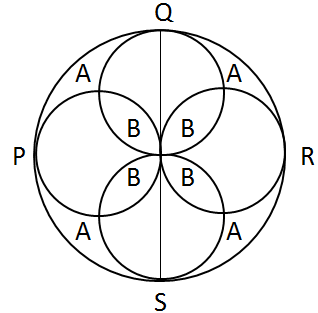
- a)π
- b)1
- c)π/4
- d)2
Correct answer is option 'B'. Can you explain this answer?
PQRS is a circle and circles are drawn with PO, QO, RO and SO as diameters. Areas A and B are marked. A/B is equal to:
a)
π
b)
1
c)
π/4
d)
2

|
Divey Sethi answered |
Such questions are all about visualization and ability to write one area in terms of others.
Here, Let the radius of PQRS be 2r
∴ Radius of each of the smaller circles = 2r/2 = r
∴ Area A can be written as:
A = π (2r)2 – 4 x π(r)2 (Area of the four smaller circles) + B (since, B has been counted twice in the previous subtraction)
Here, Let the radius of PQRS be 2r
∴ Radius of each of the smaller circles = 2r/2 = r
∴ Area A can be written as:
A = π (2r)2 – 4 x π(r)2 (Area of the four smaller circles) + B (since, B has been counted twice in the previous subtraction)
A = 4πr2 - 4πr2 + B
A = B
A/B = 1
A = B
A/B = 1
Choice (B) is therefore, the correct answer.
Correct Answer: 1
Correct Answer: 1
The ratio of the sides of Δ ABC is 1:2:4. What is the ratio of the altitudes drawn onto these sides?- a)4:2:1
- b)1:2:4
- c)1:4:16
- d)None of these
Correct answer is option 'D'. Can you explain this answer?
The ratio of the sides of Δ ABC is 1:2:4. What is the ratio of the altitudes drawn onto these sides?
a)
4:2:1
b)
1:2:4
c)
1:4:16
d)
None of these
|
|
Aakash Giery answered |
Sum of any two sides should be greater than third side.
here 1+2=3 is not less than 4 ,
1+2<4 ,so="" triangle="" is="" not="" possible.="" ,so="" triangle="" is="" not="">
here 1+2=3 is not less than 4 ,
1+2<4 ,so="" triangle="" is="" not="" possible.="" ,so="" triangle="" is="" not="">
Find the value of x in the given figure.

- a)16 cm
- b)7 cm
- c)12 cm
- d)9 cm
Correct answer is option 'D'. Can you explain this answer?
Find the value of x in the given figure.

a)
16 cm
b)
7 cm
c)
12 cm
d)
9 cm

|
Pooja Sen answered |
Isosceles trapezium is always cyclic The sum of opposite angles of a cyclic quadrilateral is 180°
Read the passage below and solve the questions based on it The area of a square is equal lo the area of a rectangle. Moreover, the perimeter of the square is also equal to the perimeter of the rectangle,Q.The length of the rectangle is equal to the:a)Breadth of the rectangleb)Side of the squarec)Cannot be determinedd)Both [1] and [2]Correct answer is option 'D'. Can you explain this answer?
|
|
Nikita Singh answered |
This is possible only when both the length and breadth of the rectangle are equal to the side of the square.
If the edge of a cube is 1 cm then which of the following is its total surface area?- a)1 cm2
- b)4 cm2
- c)6 cm2
- d)none of these
Correct answer is option 'C'. Can you explain this answer?
If the edge of a cube is 1 cm then which of the following is its total surface area?
a)
1 cm2
b)
4 cm2
c)
6 cm2
d)
none of these
|
|
Stuti Basak answered |
Explanation:
To find the total surface area of a cube, we need to find the area of all its six faces and add them up. Since all the faces of a cube are identical squares, we can find the area of one face and multiply it by 6 to get the total surface area.
Given, the edge of the cube is 1 cm. Therefore, the area of one face of the cube is:
Area of square = side × side
Area of square = 1 cm × 1 cm
Area of square = 1 cm²
To find the total surface area of the cube, we need to multiply the area of one face by 6:
Total surface area of cube = 6 × area of one face
Total surface area of cube = 6 × 1 cm²
Total surface area of cube = 6 cm²
Therefore, the total surface area of the cube is 6 cm², which is option C.
To find the total surface area of a cube, we need to find the area of all its six faces and add them up. Since all the faces of a cube are identical squares, we can find the area of one face and multiply it by 6 to get the total surface area.
Given, the edge of the cube is 1 cm. Therefore, the area of one face of the cube is:
Area of square = side × side
Area of square = 1 cm × 1 cm
Area of square = 1 cm²
To find the total surface area of the cube, we need to multiply the area of one face by 6:
Total surface area of cube = 6 × area of one face
Total surface area of cube = 6 × 1 cm²
Total surface area of cube = 6 cm²
Therefore, the total surface area of the cube is 6 cm², which is option C.
The dimensions of a rectangular box are in the ratio of 1:2:4 and the difference between the costs of covering it with the cloth and a sheet at the rate of Rs 20 and Rs 20.5 per sq m respectively is Rs 126. Find the dimensions of the box.- a)2 m, 6 m, 9 m
- b)6 m, 12 m, 24 m
- c)1 m, 2 m, 4 m
- d)None of these
Correct answer is option 'D'. Can you explain this answer?
The dimensions of a rectangular box are in the ratio of 1:2:4 and the difference between the costs of covering it with the cloth and a sheet at the rate of Rs 20 and Rs 20.5 per sq m respectively is Rs 126. Find the dimensions of the box.
a)
2 m, 6 m, 9 m
b)
6 m, 12 m, 24 m
c)
1 m, 2 m, 4 m
d)
None of these

|
Debanshi Rane answered |
The area of a rhombus is 200 cm², and one of its diagonals is 20 cm. The length of the other diagonal is _____- a)20 cm
- b)20 m
- c)22 cm
- d)22 m
Correct answer is option 'A'. Can you explain this answer?
The area of a rhombus is 200 cm², and one of its diagonals is 20 cm. The length of the other diagonal is _____
a)
20 cm
b)
20 m
c)
22 cm
d)
22 m

|
EduRev Class 8 answered |
Let the length of one diagonal be d1 = 20 cm, and the length of the other diagonal be d2
The formula for the area of a rhombus is:
Area = 1/2 x d1 x d
Area = 1/2 x d1 x d
2
Substitute the given values:
200 cm² = 1/2 x 20 x d2
200 cm² = 10 x d2
20cm = d2
The volume of two spheres are in the ratio 27 : 125. The ratio of their surface area is?- a)25 : 9
- b)27 : 11
- c)11 : 27
- d)9 : 25
Correct answer is option 'D'. Can you explain this answer?
The volume of two spheres are in the ratio 27 : 125. The ratio of their surface area is?
a)
25 : 9
b)
27 : 11
c)
11 : 27
d)
9 : 25
|
|
Sagar Sharma answered |
Understanding the Volume and Surface Area of Spheres
The problem states that the volumes of two spheres are in the ratio 27:125. To find the ratio of their surface areas, we need to understand the relationships between the two.
Volume of a Sphere
- The formula for the volume (V) of a sphere is given by V = (4/3)πr^3, where r is the radius.
- If the volumes of two spheres are in the ratio 27:125, we can express this as:
- V1/V2 = 27/125
Finding the Ratio of Radii
- Since volumes are proportional to the cube of the radii, we have:
- (r1^3)/(r2^3) = 27/125
- Taking the cube root on both sides gives us:
- r1/r2 = (27^(1/3))/(125^(1/3)) = 3/5
Surface Area of a Sphere
- The formula for the surface area (A) of a sphere is A = 4πr^2.
- Now, to find the ratio of the surface areas of the two spheres, we have:
- A1/A2 = (4πr1^2)/(4πr2^2) = (r1^2)/(r2^2)
Calculating the Surface Area Ratio
- Substituting the ratio of the radii:
- r1/r2 = 3/5
- Therefore, (r1^2)/(r2^2) = (3^2)/(5^2) = 9/25
Final Answer
- The ratio of the surface areas of the two spheres is 9:25, which corresponds to option 'D'.
The problem states that the volumes of two spheres are in the ratio 27:125. To find the ratio of their surface areas, we need to understand the relationships between the two.
Volume of a Sphere
- The formula for the volume (V) of a sphere is given by V = (4/3)πr^3, where r is the radius.
- If the volumes of two spheres are in the ratio 27:125, we can express this as:
- V1/V2 = 27/125
Finding the Ratio of Radii
- Since volumes are proportional to the cube of the radii, we have:
- (r1^3)/(r2^3) = 27/125
- Taking the cube root on both sides gives us:
- r1/r2 = (27^(1/3))/(125^(1/3)) = 3/5
Surface Area of a Sphere
- The formula for the surface area (A) of a sphere is A = 4πr^2.
- Now, to find the ratio of the surface areas of the two spheres, we have:
- A1/A2 = (4πr1^2)/(4πr2^2) = (r1^2)/(r2^2)
Calculating the Surface Area Ratio
- Substituting the ratio of the radii:
- r1/r2 = 3/5
- Therefore, (r1^2)/(r2^2) = (3^2)/(5^2) = 9/25
Final Answer
- The ratio of the surface areas of the two spheres is 9:25, which corresponds to option 'D'.
Two circles of an equal radii are drawn, without a... moreny overlap, in a semicircle of radius 2 cm. If these are the largest possible circles that the semicircle can accommodate, what is the radius (in cm) of each of the circles?a)0.414b)0.828c)0.172d)0.586Correct answer is option 'B'. Can you explain this answer?

|
Naveen Unni answered |
A square is inscribed in a semi circle of radius 10 cm. What is the area of the inscribed square? (Given that the side of the square is along the diameter of the semicircle.)- a)70 cm2
- b)50 cm2
- c)25 cm2
- d)80 cm2
Correct answer is option 'D'. Can you explain this answer?
A square is inscribed in a semi circle of radius 10 cm. What is the area of the inscribed square? (Given that the side of the square is along the diameter of the semicircle.)
a)
70 cm2
b)
50 cm2
c)
25 cm2
d)
80 cm2
|
|
Aarav Sharma answered |
Given:
Radius of the semicircle = 10 cm
Side of the square is along the diameter of the semicircle
To find:
Area of the inscribed square
Solution:
Let's draw the diagram and try to solve the problem.
[Insert Image]
1. Draw a semicircle of radius 10 cm.
[Insert Image]
2. Draw a diameter of the semicircle. Let's call it AB.
[Insert Image]
3. Draw a square ABCD with AB as one of its sides.
[Insert Image]
4. Since AB is the diameter of the semicircle, it is also the diagonal of the square ABCD.
[Insert Image]
5. Let's find the length of the side of the square.
Using Pythagoras theorem,
AB² = BC² + AC²
AB² = 10² + BC²
Since ABCD is a square, BC = CD = DA
AB² = 10² + BC² + BC²
AB² = 10² + 2BC²
BC² = (AB² - 10²)/2
BC = (AB² - 10²)/2√2
But AB = side of the square
Side of the square = (AB² - 10²)/2√2
Side of the square = (20² - 10²)/2√2
Side of the square = 10√2 cm
6. Now, we can find the area of the square.
Area of the square = (Side of the square)²
Area of the square = (10√2)²
Area of the square = 100 x 2
Area of the square = 200 cm²
Therefore, the area of the inscribed square is 200 cm².
Hence, the correct option is (D) 80 cm².
Radius of the semicircle = 10 cm
Side of the square is along the diameter of the semicircle
To find:
Area of the inscribed square
Solution:
Let's draw the diagram and try to solve the problem.
[Insert Image]
1. Draw a semicircle of radius 10 cm.
[Insert Image]
2. Draw a diameter of the semicircle. Let's call it AB.
[Insert Image]
3. Draw a square ABCD with AB as one of its sides.
[Insert Image]
4. Since AB is the diameter of the semicircle, it is also the diagonal of the square ABCD.
[Insert Image]
5. Let's find the length of the side of the square.
Using Pythagoras theorem,
AB² = BC² + AC²
AB² = 10² + BC²
Since ABCD is a square, BC = CD = DA
AB² = 10² + BC² + BC²
AB² = 10² + 2BC²
BC² = (AB² - 10²)/2
BC = (AB² - 10²)/2√2
But AB = side of the square
Side of the square = (AB² - 10²)/2√2
Side of the square = (20² - 10²)/2√2
Side of the square = 10√2 cm
6. Now, we can find the area of the square.
Area of the square = (Side of the square)²
Area of the square = (10√2)²
Area of the square = 100 x 2
Area of the square = 200 cm²
Therefore, the area of the inscribed square is 200 cm².
Hence, the correct option is (D) 80 cm².
Three circles with radius 2 cm touch each other as shown :- 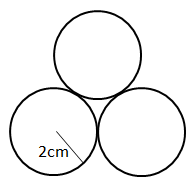
- a)3π(4+√3)2
- b)π/2(4+2√3)2
- c)π/4(4+2√3)2
- d)12π−π/2(4+2√3)2
Correct answer is option 'B'. Can you explain this answer?
Three circles with radius 2 cm touch each other as shown :-
a)
3π(4+√3)2
b)
π/2(4+2√3)2
c)
π/4(4+2√3)2
d)
12π−π/2(4+2√3)2

|
Mainak Majumdar answered |
(This can easily be derived using trigonometry. However, please remember this formula. It is useful at places)
Anil grows tomatoes in his backyard which is in the shape of a square. Each tomato takes 1 cm2 in his backyard. This year, he has been able to grow 131 more tomatoes than last year. The shape of the backyard remained a square. How many tomatoes did Anil produce this year?- a)4225
- b)4096
- c)4356
- d)Insufficient Data
Correct answer is option 'C'. Can you explain this answer?
Anil grows tomatoes in his backyard which is in the shape of a square. Each tomato takes 1 cm2 in his backyard. This year, he has been able to grow 131 more tomatoes than last year. The shape of the backyard remained a square. How many tomatoes did Anil produce this year?
a)
4225
b)
4096
c)
4356
d)
Insufficient Data

|
Naveen Jain answered |
Let the area of backyard be x2 this year and y2 last year
∴ X2- Y2 = 131
=) (X+Y) (X-Y) = 131
Now, 131 is a prime number (a unique one too. Check out its properties on Google). Also, always identify the prime number given in a question. Might be helpful in cracking the solution.
=) (X+Y) (X-Y) = 131 x 1
=) X+Y = 131
X-Y = 1
=) 2X = 132 =) X = 66
and Y = 65
∴ Number of tomatoes produced this year = 662 = 4356
Choice (C) is therefore, the correct answer.
Correct Answer: 4356
∴ X2- Y2 = 131
=) (X+Y) (X-Y) = 131
Now, 131 is a prime number (a unique one too. Check out its properties on Google). Also, always identify the prime number given in a question. Might be helpful in cracking the solution.
=) (X+Y) (X-Y) = 131 x 1
=) X+Y = 131
X-Y = 1
=) 2X = 132 =) X = 66
and Y = 65
∴ Number of tomatoes produced this year = 662 = 4356
Choice (C) is therefore, the correct answer.
Correct Answer: 4356
A pond 100 m in diameter is surrounded by a circular grass walk-way 2 m wide. How many square metres of grass is the on the walk-way?- a)98 π
- b)100 π
- c)204 π
- d)202 π
Correct answer is option 'C'. Can you explain this answer?
A pond 100 m in diameter is surrounded by a circular grass walk-way 2 m wide. How many square metres of grass is the on the walk-way?
a)
98 π
b)
100 π
c)
204 π
d)
202 π
|
|
Aarav Sharma answered |
The radius of the pond is 100/2 = <100 =50="">>50 m.
The radius of the grass walkway is 50+2 = <50+2=52>>52 m.
The area of the grass walkway is pi*(52^2 - 50^2) = pi*(2704 - 2500) = pi*204
≈ 204*pi
≈ 204*3.14
≈ <204*3.14=640.56>>640.56 m^2.
So, the answer is a) 640.
The radius of the grass walkway is 50+2 = <50+2=52>>52 m.
The area of the grass walkway is pi*(52^2 - 50^2) = pi*(2704 - 2500) = pi*204
≈ 204*pi
≈ 204*3.14
≈ <204*3.14=640.56>>640.56 m^2.
So, the answer is a) 640.
In the given figure, AD is the bisector of ∠BAC, AB = 6 cm, AC = 5 cm and BD = 3 cm. Find DC. It is given that ∠ABD = ∠ACD.
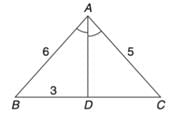
- a)11.3 cm
- b)4 cm
- c)3.5 cm
- d)2.5 cm
Correct answer is option 'D'. Can you explain this answer?
In the given figure, AD is the bisector of ∠BAC, AB = 6 cm, AC = 5 cm and BD = 3 cm. Find DC. It is given that ∠ABD = ∠ACD.

a)
11.3 cm
b)
4 cm
c)
3.5 cm
d)
2.5 cm
|
|
Pooja Shah answered |
We know that the internal bisector of angle of a triangle divides the opposite side internally in the ratio of the sides containing the angle.
Hence:
Hence:
In triangle ABD and ACD
Angle BAD = CAD (Given AD is the bisector)
Angle ABD = ACD (GIven)
there fore they are similar (AAA Property)
AB/BD = AC/CD
6/3 = 5/CD
CD = 2.5 cm
6/3 = 5/CD
CD = 2.5 cm
The area of the circle is 2464 cm2 and the ratio of the breadth of the rectangle to radius of the circle is 6:7. If the circumference of the circle is equal to the perimeter of the rectangle, then what is the area of the rectangle.- a)1456 cm2
- b)1536 cm2
- c)1254 cm2
- d)5678 cm2
Correct answer is option 'B'. Can you explain this answer?
The area of the circle is 2464 cm2 and the ratio of the breadth of the rectangle to radius of the circle is 6:7. If the circumference of the circle is equal to the perimeter of the rectangle, then what is the area of the rectangle.
a)
1456 cm2
b)
1536 cm2
c)
1254 cm2
d)
5678 cm2
|
|
Luminary Institute answered |
Area of the circle=πr2
2464 = 22/7 * r2
Radius of the circle=28 cm
Circumference of the circle=2 * π* r =2 * 22/7 * 28
= 176 cm
Breadth of the rectangle=6/7 * 28=24 cm
Perimeter of the rectangle=2 * (l + b)
176 = 2 * (l + 24)
Length of the rectangle = 64 cm
Area of the rectangle = l * b = 24 * 64 = 1536 cm2
ABCD is a square drawn inside a square PTRS of sides 4 cm by joining midpoints of the sides PR, PT, TS, SR. Another square is drawn inside ABCD similarly. This process is repeated infinite number of times. Find the sum of all the squares.
- a)16 cm2
- b)28 cm2
- c)32 cm2
- d)Infinite
Correct answer is option 'C'. Can you explain this answer?
ABCD is a square drawn inside a square PTRS of sides 4 cm by joining midpoints of the sides PR, PT, TS, SR. Another square is drawn inside ABCD similarly. This process is repeated infinite number of times. Find the sum of all the squares.
a)
16 cm2
b)
28 cm2
c)
32 cm2
d)
Infinite

|
Rajdeep Verma answered |
If we write the infinite series of area of squares:
= 42 + (2√2)2 + 22 + ……. infinite
Since it is a decreasing series sum of infinite terms can be approximated.
= 16 + 8 + 4 +………infinite
Two sides of a triangle are 4 and 5. Then, for the area of the triangle, which one of the following bounds is the sharpest?- a)<10.
- b)≤ 10.
- c)< 8.
- d)> 5.
Correct answer is option 'B'. Can you explain this answer?
Two sides of a triangle are 4 and 5. Then, for the area of the triangle, which one of the following bounds is the sharpest?
a)
<10.
b)
≤ 10.
c)
< 8.
d)
> 5.

|
Prerna Choudhary answered |
Let AB = 4 and BC = 5 and AB is perpendicular to BC
then Area = 1/2 AB . AC = 1/2 . 4.5 = 10
In the given figure, straight line AB and CD intersect at O. IF ∠δ =3∠v, then ∠v = ?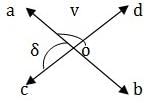
- a)40⁰
- b)50⁰
- c)55⁰
- d)45⁰
Correct answer is option 'D'. Can you explain this answer?
In the given figure, straight line AB and CD intersect at O. IF ∠δ =3∠v, then ∠v = ?

a)
40⁰
b)
50⁰
c)
55⁰
d)
45⁰
|
|
Meera Kapoor answered |
COD is a straight line
∴ ∠δ + ∠v =180⁰ ⇒ 3v +v =180 ⇒ 4v = 180 ⇒ v =45⁰.
∴ ∠δ + ∠v =180⁰ ⇒ 3v +v =180 ⇒ 4v = 180 ⇒ v =45⁰.
If the parallel sides of a parallelogram are 2 cm apart and their sum is 10 cm then its area is:- a)20 cm2
- b)5 cm2
- c)10 cm2
- d)none of these
Correct answer is option 'C'. Can you explain this answer?
If the parallel sides of a parallelogram are 2 cm apart and their sum is 10 cm then its area is:
a)
20 cm2
b)
5 cm2
c)
10 cm2
d)
none of these
|
|
Srestha Menon answered |
Understanding the Parallelogram Area
To find the area of a parallelogram, we can use the formula:
Area = base × height
Where:
- The base is the length of one of the parallel sides.
- The height is the perpendicular distance between the parallel sides.
Given Information
- The distance between the parallel sides (height) = 2 cm
- The sum of the lengths of the parallel sides = 10 cm
Finding the Base
Since we have the sum of the two parallel sides, we can define their lengths as follows:
Let one side be "a" and the other side be "b". According to the problem:
a + b = 10 cm
To find the area, we need the length of one of the sides. For simplicity, let's assume both sides are equal. Thus:
a = b = 10 cm / 2 = 5 cm
Calculating the Area
Now, substituting the values into the area formula:
Area = base × height
Area = 5 cm × 2 cm
Area = 10 cm²
Conclusion
The area of the parallelogram is 10 cm². Hence, the correct answer is option 'C'. This demonstrates how understanding the properties of parallelograms can help solve geometry problems effectively.
To find the area of a parallelogram, we can use the formula:
Area = base × height
Where:
- The base is the length of one of the parallel sides.
- The height is the perpendicular distance between the parallel sides.
Given Information
- The distance between the parallel sides (height) = 2 cm
- The sum of the lengths of the parallel sides = 10 cm
Finding the Base
Since we have the sum of the two parallel sides, we can define their lengths as follows:
Let one side be "a" and the other side be "b". According to the problem:
a + b = 10 cm
To find the area, we need the length of one of the sides. For simplicity, let's assume both sides are equal. Thus:
a = b = 10 cm / 2 = 5 cm
Calculating the Area
Now, substituting the values into the area formula:
Area = base × height
Area = 5 cm × 2 cm
Area = 10 cm²
Conclusion
The area of the parallelogram is 10 cm². Hence, the correct answer is option 'C'. This demonstrates how understanding the properties of parallelograms can help solve geometry problems effectively.
The length of each side of a cube is 24 cm. The volume of the cube is equal to the volume of a cuboid. If the breadth and the height of the cuboid are 32 cm and 12 cm, respectively, then what will be the length of the cuboid?- a)36
- b)27
- c)16
- d)20
Correct answer is option 'A'. Can you explain this answer?
The length of each side of a cube is 24 cm. The volume of the cube is equal to the volume of a cuboid. If the breadth and the height of the cuboid are 32 cm and 12 cm, respectively, then what will be the length of the cuboid?
a)
36
b)
27
c)
16
d)
20
|
|
Nitin Majumdar answered |
Volume of the Cube
To find the volume of the cube, we use the formula:
- Volume = side × side × side
For a cube with each side measuring 24 cm:
- Volume = 24 cm × 24 cm × 24 cm = 13,824 cm³
Volume of the Cuboid
The volume of the cuboid is also given to be equal to the volume of the cube, which is 13,824 cm³.
Dimensions of the Cuboid
We know the following dimensions of the cuboid:
- Breadth = 32 cm
- Height = 12 cm
Let the length of the cuboid be denoted as 'l'. The formula for the volume of the cuboid is:
- Volume = length × breadth × height
Substituting the known values:
- 13,824 cm³ = l × 32 cm × 12 cm
Calculating the Length
Now, we need to solve for 'l':
1. First, calculate the product of the breadth and height:
- 32 cm × 12 cm = 384 cm²
2. Now, substitute this into the volume equation:
- 13,824 cm³ = l × 384 cm²
3. To find 'l', divide both sides by 384 cm²:
- l = 13,824 cm³ / 384 cm²
- l = 36 cm
Conclusion
Thus, the length of the cuboid is 36 cm.
The correct answer is option 'A'.
To find the volume of the cube, we use the formula:
- Volume = side × side × side
For a cube with each side measuring 24 cm:
- Volume = 24 cm × 24 cm × 24 cm = 13,824 cm³
Volume of the Cuboid
The volume of the cuboid is also given to be equal to the volume of the cube, which is 13,824 cm³.
Dimensions of the Cuboid
We know the following dimensions of the cuboid:
- Breadth = 32 cm
- Height = 12 cm
Let the length of the cuboid be denoted as 'l'. The formula for the volume of the cuboid is:
- Volume = length × breadth × height
Substituting the known values:
- 13,824 cm³ = l × 32 cm × 12 cm
Calculating the Length
Now, we need to solve for 'l':
1. First, calculate the product of the breadth and height:
- 32 cm × 12 cm = 384 cm²
2. Now, substitute this into the volume equation:
- 13,824 cm³ = l × 384 cm²
3. To find 'l', divide both sides by 384 cm²:
- l = 13,824 cm³ / 384 cm²
- l = 36 cm
Conclusion
Thus, the length of the cuboid is 36 cm.
The correct answer is option 'A'.
Top surface of a raised platform is in the shape of regular octagon as shown in the figure. Find the area of the octagonal surface.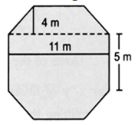
- a)11.9 cm3
- b)119 cm
- c)119 m2
- d)None of these
Correct answer is option 'C'. Can you explain this answer?
Top surface of a raised platform is in the shape of regular octagon as shown in the figure. Find the area of the octagonal surface.

a)
11.9 cm3
b)
119 cm
c)
119 m2
d)
None of these

|
Trisha Vashisht answered |
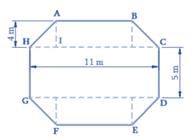
We will divide the octagon in 3 parts which are two trpeziums ABCH and DEFG and one rectangle CDGH and find the area for all of them separately and add them to get the area of octagon

AB is the diameter of the circle and ∠PAB=40∘
what is the value of ∠PCA?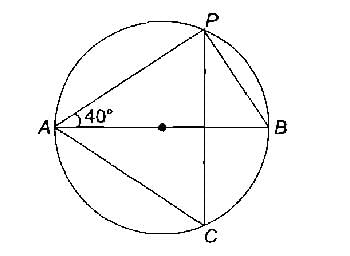
- a)50∘
- b)55°
- c)70°
- d)45°
Correct answer is option 'A'. Can you explain this answer?
AB is the diameter of the circle and ∠PAB=40∘
what is the value of ∠PCA?
what is the value of ∠PCA?

a)
50∘
b)
55°
c)
70°
d)
45°

|
KS Coaching Center answered |
- In △PAB⇒ ∠PAB=40o [ Given ]⇒ ∠BPA=90o [ angle inscribed in a semi-circle ]⇒ ∠PAB+∠PBA+∠BPA=180o∴ 40o+∠PBA+90o=180o∴ ∠PBA=180o−130o∴ ∠PBA=50o⇒ ∠PBA=∠PCA=50o [ angles inscribed in a same arc PA ]∴ ∠PCA=50o
What is the area of the triangle below?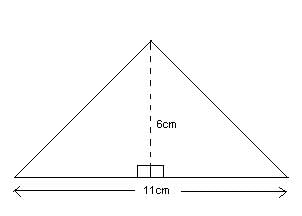
- a)22 cm2
- b)33 cm2
- c)44 cm2
- d)50 cm2
Correct answer is option 'B'. Can you explain this answer?
What is the area of the triangle below?

a)
22 cm2
b)
33 cm2
c)
44 cm2
d)
50 cm2

|
Pritam Saha answered |
The area of a triangle may be found by using the formula, A=1/2bh, where brepresents the base and h represents the height. Thus, the area may be written as A=1/2(11)(6), or A = 33. The area of the triangle is 33 cm'.
Chapter doubts & questions for Mensuration and geometry - General Aptitude for GATE 2025 is part of Mechanical Engineering exam preparation. The chapters have been prepared according to the Mechanical Engineering exam syllabus. The Chapter doubts & questions, notes, tests & MCQs are made for Mechanical Engineering 2025 Exam. Find important definitions, questions, notes, meanings, examples, exercises, MCQs and online tests here.
Chapter doubts & questions of Mensuration and geometry - General Aptitude for GATE in English & Hindi are available as part of Mechanical Engineering exam.
Download more important topics, notes, lectures and mock test series for Mechanical Engineering Exam by signing up for free.
General Aptitude for GATE
206 videos|190 docs|158 tests
|

Contact Support
Our team is online on weekdays between 10 AM - 7 PM
Typical reply within 3 hours
|
Free Exam Preparation
at your Fingertips!
Access Free Study Material - Test Series, Structured Courses, Free Videos & Study Notes and Prepare for Your Exam With Ease

 Join the 10M+ students on EduRev
Join the 10M+ students on EduRev
|

|
Create your account for free
OR
Forgot Password
OR
Signup to see your scores
go up
within 7 days!
within 7 days!
Takes less than 10 seconds to signup




